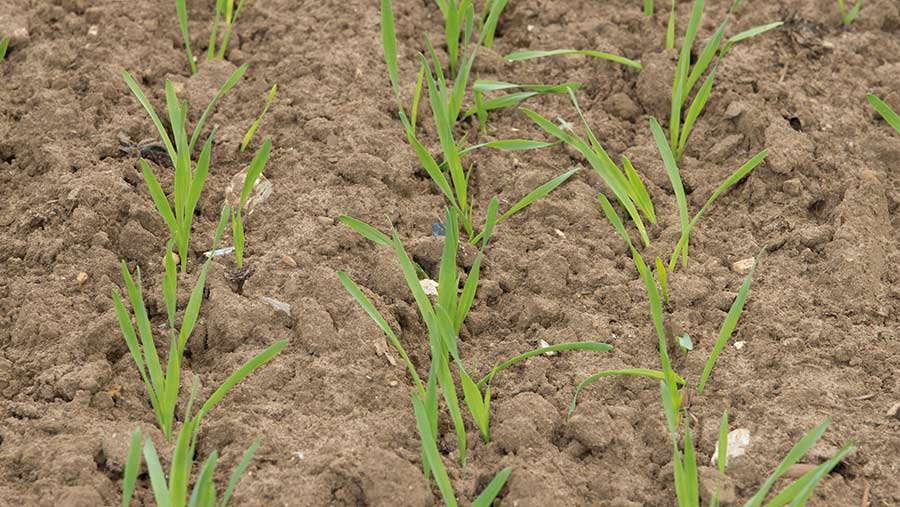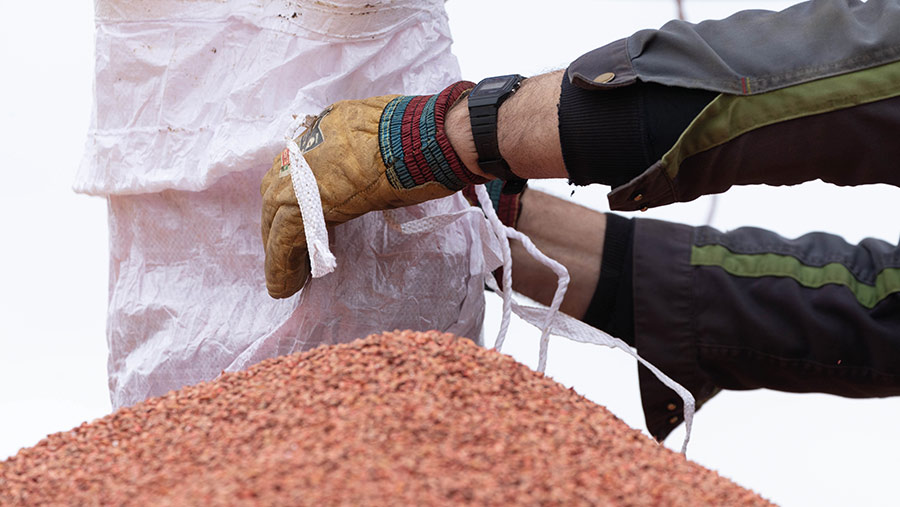Why field loss is important for seed rate calculations
 © Tim Scrivener
© Tim Scrivener Calculating the correct seed rate is essential in achieving optimum wheat plant populations and, therefore, must be accounted for each year.
Thousand-seed weight (TSW), field losses, soil type and sowing date all govern the rate at which seeds should be drilled.
Hutchinsons technical manager Dick Neale explains that too often seed rates are calculated according to the target plant population, when more emphasis should be placed on germination and field losses.
Seed rate (kg/ha) is calculated by multiplying the target plant establishment (plants/sq m) by TSW (grams) and dividing by the expected establishment as a percentage.
See also: The importance of larger seed sizes for farm saved seed
For a crop of winter wheat, the target plant number varies very little. For a crop drilled from late September onwards, growers should aim for 220-240 plants/sq m surviving at the beginning of March.
“Arguably, the target plant population should stay at 240 plants/sq m,” says Mr Neale. “The elements that should be adjusted are thousand-seed weight, germination and field loss percentages.”
Germination and field losses
Each season, a proportion of viable seeds fail to emerge due to frost, weeds, pests, diseases and poor soil conditions. Soil type and cultivations also have strong effects on establishment.
Average establishment is affected by the percentage germination loss and the predicted percentage field loss. Germination losses for autumn UK established cereals average 4-10%, while over-winter field losses average 33%.
Field losses vary according to soil type, with lighter soils and better performing seed-beds experiencing fewer seed losses at about 23%.
For heavier soils drilled later for grassweed control, an additional 10% field loss is expected, resulting in a field loss of up to 43%.
“A 30-40% field loss in medium to heavy bodied soils is reality,” says Mr Neale.
“While the best bits of fields may have improved establishment, it is the removal of variation from the poor establishing areas that can dramatically raise overall average crop performance.”
“For many years we have communicated that seed rates were not high enough and failed to account for 33% field loss, the required competition for weed control, and not allowing for the variation we know that exists across fields.”

© Tim Scrivener
Advice for the 2022 drilling season
Soil temperatures at depth will remain high this year, driving winter growth.
Combined with the fact that soils are currently up to 150mm in moisture deficit, this means it will take significant rainfall before they become “wet” this autumn.
TSW significantly influences rates, and winter wheat seed already processed this season is coming in between 43-56g, with an average of 51g. This range represents a difference of 100 seeds/sq m at a standard drilled weight.
Seed rates should therefore be calculated according to the parameters of 240 plants/sq m established with at least a 33% field loss.
“Once the number of seeds/sq m to be drilled is known, such as 410/sq m, seed should be ordered or processed on farm on the basis of this many seeds germinating/sq m,” explains Mr Neale.
“Once the processor is aware of the batch TSW, they can calculate the amount of seed required and deliver or dress exactly the right amount,” he adds.
There are then additional field-loss factors to consider. For example, drilling on 21 October at a TSW of 52g, the basic seed rate should be 190kg/ha.
In a cloddy seed-bed where slugs might be a factor, add 10% for slugs and 10% for the cloddy seed-bed. Total seeding rate is thus 190kg/ha + 20% = 228kg/ha = 438 seeds/sq m.
“This calculation is fundamental to establishing the optimum potential within crops. Drilling by weight is pure guesswork and it is a change in approach that is so simple to achieve,” Mr Neale says.
Variable seed rate drilling is another impactful precision farming practice that can be implemented, to further improve crop establishment, minimise field losses and improve input efficiencies.
The impact of sowing dates
Delayed sowing, which may be necessary for weed control or due to soil conditions, reduces tillering as establishment declines when sowing is delayed beyond mid-October.
For each month drilling is delayed, an extra 50 plants/sq m are typically required to compensate for reduced tillering.
However, high seed rates coupled with good establishment can increase lodging risk, because high plant population density weakens plant anchorage, increases shoot height and decreases stem strength.
The proportion of seeds that emerge also appears to decrease as the rate of seeds sown is increased.
This year’s harvest
Growers this year harvested some of the highest yields seen for many years, on all but the lightest soils, and Mr Neale believes good establishment conditions last autumn contributed to this.
Last season, many drilled more seed as a result of a very low TSW of 41g, in order to achieve more consistent plant stands.
With good seed-bed conditions and overwinter soil temperatures the highest for 30 years, the “foundation period” conditions allowed for strong rooting and tillering.
The root mass in particular kept the crops going even as the soils dried. The icing on the cake was then high solar radiation levels, to allow all the potential set up to be realised.
Mr Neale says: “It was obvious with the initial thickness of crop stands that many growers still drilled by weight/ha and with low TSW, a significantly higher number of seeds/sq m got drilled.”
This year’s drilling
The main difference this year is that TSW is back to the more usual 51g/1,000 seeds compared with last year’s low.
For example: 180kg/ha seed drilled at a 41g TSW = 439 seeds/sq m compared with 180kg/ha seed drilled at a 51g TSW = 352 seeds/sq m.
Allowing for germination percentage and average field loss, this means 439 drilled seeds = 279 established plants. After winter loss of 10% = 250 plants/sq m.
For 352 drilled seeds = 224 established plants. After winter loss of 10% = 201 plants/sq m.
Mr Neale believes that while growers adjusted many parameters of crop input in 2021-22, it cannot be ignored that many unwittingly increased their plants/sq m established last year by nearly a quarter.

